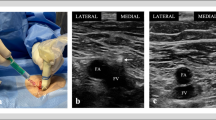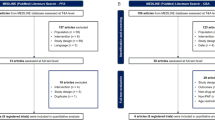Abstract
Background
Catheter ablation is considered as the mainstay treatment for patients with symptomatic atrial fibrillation (AF). We aimed to determine the predictors of 30-day readmission after catheter ablation for AF.
Methods
The study cohort consisted of patients who underwent AF catheter ablation (International Classification of Diseases, Ninth Revision 427.31 and procedure code 37.34) in 2014, identified from the National Readmission Database.
Results
Our final cohort consisted of 5322 unweighted cases, of which 4736 (89%) constituted the no-readmission group and 586 patients (11%) the readmission group. Female gender (OR 1.62, 95% CI 1.35–1.95), CAD (OR 1.36, 95% CI 1.08–1.71), peripheral vascular disease (OR 1.45, 95% CI 1.07–1.98), acute renal failure (OR 1.46, 95% CI 1.09–1.97), fluid and electrolyte disorders (OR 1.32, 95% CI 1.03–1.67), chronic pulmonary disease (OR 1.25, 95% CI 1.01–1.53), ablation on the day of admission (OR 0.74, 95% CI 0.61–0.91), and fourth quartile of hospital AF catheter ablation volume (OR 0.60, 95% CI 0.45–0.80) were independent predictors of 30-day readmission. Arrhythmias and heart failure were the most common cardiac etiologies for readmission. The most common ablation-related complications were hemorrhage (11%) and vascular (7%) complications.
Conclusions
Several patient- and hospital-related factors were identified as predictors of 30-day readmission, the knowledge of which can potentially improve healthcare delivery.



Similar content being viewed by others
Abbreviations
- AF:
-
Atrial fibrillation
- NIS:
-
National Inpatient Sample
- NRD:
-
National Readmission Database
- ICD-9-CM:
-
International Classification of Diseases, Ninth Revision, Clinical Modification
- LOS:
-
Length of stay
- IQR:
-
Interquartile range
- CAD:
-
Coronary artery disease
- PVD:
-
Peripheral vascular disease
- ARF:
-
Acute renal failure
- SND:
-
Sinus node dysfunction
- TIA:
-
Transient ischemic attack
References
Prevention DfHDaS (2015) Atrial Fibrillation Fact Sheet. Accessed on Jul 17, 2017. Available from https://www.cdc.gov/dhdsp/data_statistics/fact_sheets/fs_atrial_fibrillation.htm. Centers for Disease Control and Prevention.
Cappato R, Calkins H, Chen SA, Davies W, Iesaka Y, Kalman J, et al. Updated worldwide survey on the methods, efficacy, and safety of catheter ablation for human atrial fibrillation. Circ Arrhythm Electrophysiol. 2010;3(1):32–8. https://doi.org/10.1161/CIRCEP.109.859116.
Wann LS, Curtis AB, January CT, Ellenbogen KA, Lowe JE, Estes NA 3rd, et al. 2011 ACCF/AHA/HRS focused update on the management of patients with atrial fibrillation (updating the 2006 guideline): a report of the American College of Cardiology Foundation/American Heart Association Task Force on Practice Guidelines. J Am Coll Cardiol. 2011;57(2):223–42. https://doi.org/10.1016/j.jacc.2010.10.001.
Calkins H, Kuck KH, Cappato R, Brugada J, Camm AJ, Chen SA, et al. 2012 HRS/EHRA/ECAS Expert Consensus Statement on Catheter and Surgical Ablation of Atrial Fibrillation: recommendations for patient selection, procedural techniques, patient management and follow-up, definitions, endpoints, and research trial design. Europace. 2012;14(4):528–606. https://doi.org/10.1093/europace/eus027.
Cappato R, Calkins H, Chen SA, Davies W, Iesaka Y, Kalman J, et al. Worldwide survey on the methods, efficacy, and safety of catheter ablation for human atrial fibrillation. Circulation. 2005;111(9):1100–5. https://doi.org/10.1161/01.CIR.0000157153.30978.67.
Ellis ER, Culler SD, Simon AW, Reynolds MR. Trends in utilization and complications of catheter ablation for atrial fibrillation in Medicare beneficiaries. Heart Rhythm. 2009;6(9):1267–73. https://doi.org/10.1016/j.hrthm.2009.06.009.
Shah RU, Freeman JV, Shilane D, Wang PJ, Go AS, Hlatky MA. Procedural complications, rehospitalizations, and repeat procedures after catheter ablation for atrial fibrillation. J Am Coll Cardiol. 2012;59(2):143–9. https://doi.org/10.1016/j.jacc.2011.08.068.
Deshmukh A, Patel NJ, Pant S, Shah N, Chothani A, Mehta K, et al. In-hospital complications associated with catheter ablation of atrial fibrillation in the United States between 2000 and 2010: analysis of 93 801 procedures. Circulation. 2013;128(19):2104–12. https://doi.org/10.1161/CIRCULATIONAHA.113.003862.
Freeman JV, Wang Y, Akar J, Desai N, Krumholz H. National trends in atrial fibrillation hospitalization, readmission, and mortality for Medicare beneficiaries, 1999–2013. Circulation. 2017;135(13):1227–39. https://doi.org/10.1161/CIRCULATIONAHA.116.022388.
Padala SK, Gunda S, Sharma PS, Kang L, Koneru JN, Ellenbogen KA. Risk model for predicting complications in patients undergoing atrial fibrillation ablation. Heart Rhythm. 2017;14(9):1336–43. https://doi.org/10.1016/j.hrthm.2017.04.042.
Jencks SF, Williams MV, Coleman EA. Rehospitalizations among patients in the Medicare fee-for-service program. N Engl J Med. 2009;360(14):1418–28. https://doi.org/10.1056/NEJMsa0803563.
National Readmission Database (NRD). Health Care Utilization Project. Rockville: Agency for Healthcare Research and Quality; 2014. https://www.hcup-us.ahrq.gov/nrdoverview.jsp. Accessed 22 Dec 2018.
Bueno H, Ross JS, Wang Y, Chen J, Vidan MT, Normand SL, et al. Trends in length of stay and short-term outcomes among Medicare patients hospitalized for heart failure, 1993–2006. JAMA. 2010;303(21):2141–7. https://doi.org/10.1001/jama.2010.748.
Curtis JP, Schreiner G, Wang Y, Chen J, Spertus JA, Rumsfeld JS, et al. All-cause readmission and repeat revascularization after percutaneous coronary intervention in a cohort of Medicare patients. J Am Coll Cardiol. 2009;54(10):903–7. https://doi.org/10.1016/j.jacc.2009.04.076.
Piccini JP, Sinner MF, Greiner MA, Hammill BG, Fontes JD, Daubert JP, et al. Outcomes of Medicare beneficiaries undergoing catheter ablation for atrial fibrillation. Circulation. 2012;126(18):2200–7. https://doi.org/10.1161/CIRCULATIONAHA.112.109330.
Chang HY, Lin YJ, Lo LW, Chang SL, Hu YF, Li CH, et al. Sinus node dysfunction in atrial fibrillation patients: the evidence of regional atrial substrate remodelling. Europace. 2013;15(2):205–11. https://doi.org/10.1093/europace/eus219.
Sairaku A, Nakano Y, Oda N, Makita Y, Kajihara K, Tokuyama T, et al. Prediction of sinus node dysfunction in patients with persistent atrial flutter using the flutter cycle length. Europace. 2012;14(3):380–7. https://doi.org/10.1093/europace/eur305.
Eitel C, Piorkowski C, Hindricks G. Clinical relevance and management of early recurrences after catheter ablation of atrial fibrillation. Expert Rev Cardiovasc Ther. 2011;9(7):849–52. https://doi.org/10.1586/erc.11.66.
Mulder AA, Wijffels MC, Wever EF, Boersma LV. Early recurrence of atrial fibrillation as a predictor for 1-year efficacy after successful phased RF pulmonary vein isolation: evaluation of complaints and multiple Holter recordings. Int J Cardiol. 2013;165(1):56–60. https://doi.org/10.1016/j.ijcard.2011.07.079.
Phillips CO, Wright SM, Kern DE, Singa RM, Shepperd S, Rubin HR. Comprehensive discharge planning with postdischarge support for older patients with congestive heart failure: a meta-analysis. JAMA. 2004;291(11):1358–67. https://doi.org/10.1001/jama.291.11.1358.
Spragg DD, Dalal D, Cheema A, Scherr D, Chilukuri K, Cheng A, et al. Complications of catheter ablation for atrial fibrillation: incidence and predictors. J Cardiovasc Electrophysiol. 2008;19(6):627–31. https://doi.org/10.1111/j.1540-8167.2008.01181.x.
Funding
The cost of software and database was funded by Dorothy Rider Pool Trust Fund (Grant: 1573-007), Lehigh Valley Health Network.
Author information
Authors and Affiliations
Corresponding author
Ethics declarations
Conflict of interest
The authors declare that they have no conflict of interest.
Informed consent
Not applicable
Ethical approval
Not applicable
Additional information
Publisher’s Note
Springer Nature remains neutral with regard to jurisdictional claims in published maps and institutional affiliations.
Electronic supplementary material
ESM 1
(DOCX 34.7 kb)
Supplement Figure 1
(JPG 749 kb)
Supplement Figure 2
(JPG 759 kb)
Supplement Figure 3
(JPG 660 kb)
Supplement Figure 4
(JPG 758 kb)
Rights and permissions
About this article
Cite this article
Garg, J., Patel, B., Chaudhary, R. et al. Predictors of 30-day readmissions after catheter ablation for atrial fibrillation in the USA. J Interv Card Electrophysiol 55, 243–250 (2019). https://doi.org/10.1007/s10840-018-0503-3
Received:
Accepted:
Published:
Issue Date:
DOI: https://doi.org/10.1007/s10840-018-0503-3




